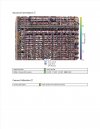- Joined
- May 9, 2021
- Messages
- 311
- Reaction score
- 153
- Age
- 69
- Location
- Kingwood, TX
- Website
- www.raptoraerialservices.com
I normally use an Autel Evo II Pro Enterprise RTK Drone, EOS Arrow Gold RTK GNSS Receiver and GCPs for my mapping projects. I borrowed a colleague's new Emlid Reach RS2 Base and tried it out for the first time today. The base does not have a cellular sim card so I was reliant on using my iOS mobile devices as a hotspot in order to get an internet connection. Making all of the pieces work together was a challenge. I decided to place the Reach Base over one of my GCPs that I determined the location with my EOS Arrow Gold RTK GNSS Receiver using the TopNet Live RTK corrections service. One of the problems I ran into early on was that the Emlid Reach RS2 Base sat on top of a BOSCH Aluminum Heavy Duty Elevator Quick Clamp Tripod (BT300). It had no level and no easy way to align the base over the center of the GCP. I eye balled it the best I could. I also surveyed in a couple of check points but used no GCPs. Using my iPhone hotspot I was able to connect to both the Emlid Reach RS2 Base and Autel Smart Controller. Also, I used the EMLID CASTER site to pass NTRIP corrections between the base and the drone using the same mount point. I was able to get a FIX solution on both the base and the drone during the entire survey.
I flew the 45 acre survey and everything seemed to go smoothly. I processed the survey shortly thereafter. It processed quickly with no issues. Flight lines were perfect as best I could tell. The resulting 2D Ortho and elevations models looked very good. Since I had flown a drone survey using GCPs earlier, I have a good base to compare the survey to. Looking at the new data closely, I noticed a slight (about a foot or so) horizontal shift in the data to the east compared to the earlier drone survey I flew. That didn't both me too much since I had trouble aligning Reach base over the GCP (known point). The bigger problem I had was that the elevation data was way off. From 50-100 ft difference from the earlier RTK survey I flew. I am not sure exactly what happened here. Since I chose Manual as the Base mode, I may not have input the height correctly since I placed the antenna and EOS Arrow Gold receiver directly on the center of the GCP to record the ellipsoid height of the known point. Probably a dumb idea.
I chalk this up to a learning exercise. I would be very interested in your feedback and any suggestions/best practices you have to successfully connect an Emlid Reach RS2 Base to an Autel Evo II Pro Enterprise RTK Drone and get good results.
I flew the 45 acre survey and everything seemed to go smoothly. I processed the survey shortly thereafter. It processed quickly with no issues. Flight lines were perfect as best I could tell. The resulting 2D Ortho and elevations models looked very good. Since I had flown a drone survey using GCPs earlier, I have a good base to compare the survey to. Looking at the new data closely, I noticed a slight (about a foot or so) horizontal shift in the data to the east compared to the earlier drone survey I flew. That didn't both me too much since I had trouble aligning Reach base over the GCP (known point). The bigger problem I had was that the elevation data was way off. From 50-100 ft difference from the earlier RTK survey I flew. I am not sure exactly what happened here. Since I chose Manual as the Base mode, I may not have input the height correctly since I placed the antenna and EOS Arrow Gold receiver directly on the center of the GCP to record the ellipsoid height of the known point. Probably a dumb idea.
I chalk this up to a learning exercise. I would be very interested in your feedback and any suggestions/best practices you have to successfully connect an Emlid Reach RS2 Base to an Autel Evo II Pro Enterprise RTK Drone and get good results.




